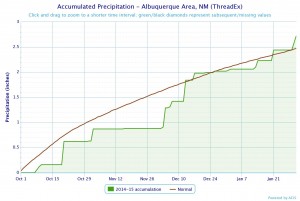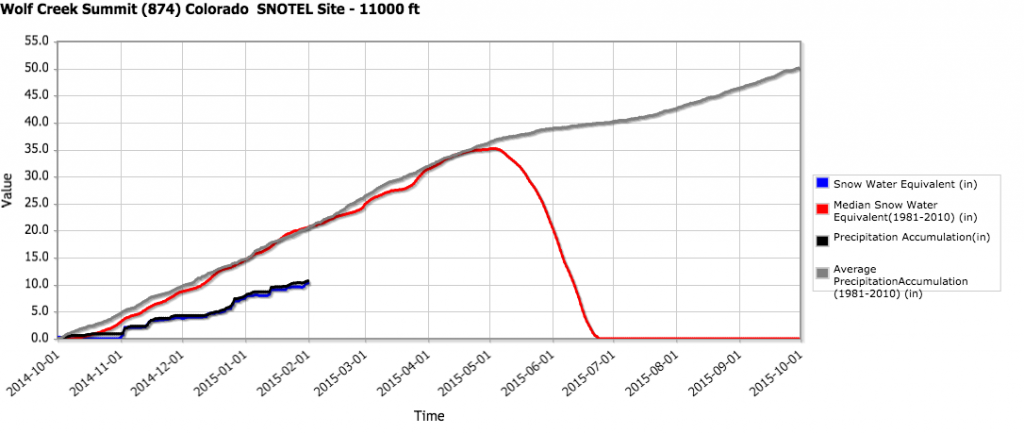tl;dr Despite good rain in the cities of New Mexico’s Rio Grande Valley this year (especially at my house!), it’s the snowpack that matters for state water supply. And the snowpack is not good.
Longer: My backyard rain barrels are full, and the latest storm has brought Albuquerque’s water year precipitation (since Oct. 1) to 2.72 inches (6.9 cm), 10 percent above the mean. Unfortunately for the state’s water users, the amount that falls in the river valleys of central New Mexico means little. It is mountain snowpack that matters.
When I was out last fall with a group of university colleagues who were doing field work for a drought vulnerability study, one of the farmers we met with told us his quick rule of thumb for keeping tabs on how much water he thinks he’ll get in the spring: he watches the Wolf Creek SNOTEL site. It’s located in the mountains above Pagosa Springs in southern Colorado, and it’s snow up in that region that will fill (or not) the rivers and reservoirs he needs to irrigate his onions. There are a lot fancier forecast tools available that many of us stare at obsessively, but if you want a quick feel for how things are shaping, Wolf Creek’s a nice proxy. The red and grey lines are the median for this time of year, the black and blue lines are the actual – roughly half.
That’s why, despite a big storm just done (arguably the wettest of the year in New Mexico), I wrote this for Albuquerque’s Sunday morning driveway read:
For the fourth consecutive year, New Mexico water users are watching a skimpy snowpack in the state’s northern mountains and worrying about how much water they will have this spring and summer.
On the state’s largest rivers – the Pecos, the Rio Grande and the San Juan – the thin covering of mountain snow means less water in early forecasts.
“The runoff looks pathetic again,” said Greg Lewis, Pecos River basin manager for the New Mexico Interstate Stream Commission.
Key messages:
- San Juan-Chama supplies, the Colorado River trans-basin diversion that brings water to the middle Rio Grande, is at risk for its second shortfall
- Santa Fe and Albuquerque, with reserves and diversified supply, will be OK despite San Juan-Chama risk
- Pecos farmers will be fine, thanks to full reservoirs from two consecutive years with huge late summer rains
- The Lower Rio Grande, from Elephant Butte Reservoir down, is in a heap of hurt. Agriculture there, especially in the Hatch Valley, is vulnerable.
We’ll have runoff forecast numbers in the coming week, so I’ll come back with something more rigorous then. In the meantime, I guess bookmark Wolf Creek?



Gratified to learn that the Taos river-running community is not the only interested party that watches Wolf Creek as a proxy for expected runoff in the Rio Grande. The Chama SNOTELs are also of abiding interest to rafters and farmers. (They usually mirror snowpacks on the San Juan side.)
If, as seems likely, the raftable rivers are going to be very low, the Middle Rio Grande farmers may also be in for a bit of the hurt.
John, Have you ever written about the Kirkland fuel spill, and it’s possible impacts? Ditto for a repository for nuclear waste that is located near a reservation just South of Albuquerque? Could either of these threaten Albuquerque’s water supply?